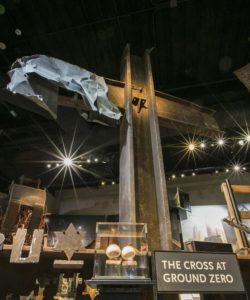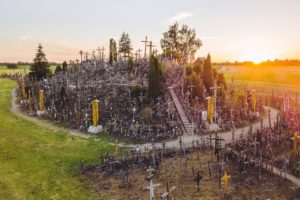“In the cross of Christ I glory, towering o’er the wrecks of time.” That is a hymn lyric that many Christians know. But the notion of the cross towering over various temporal “wrecks” gained new poignancy when we saw on the news—and for those of us who went to Lower Manhattan in the months after 9-11 we saw it also in person—that iron-girder cross towering over Ground Zero. That cross became one of the most frequently photographed parts of that grim and terrible place. It is now on permanent display as part of the 9-11 Memorial and Museum in Lower Manhattan.

For many people in this world, that’s the function of a cross: to mark a bad and tragic thing. You see fields of crosses at Arlington National Cemetery and in the vast graveyards near Normandy, France. That’s what we do: we place the cross at locations of death. We do not generally, however, sink crosses into places of life, liveliness, or anything else that has to do with our everyday business.
Even in Lower Manhattan prior to September 11, 2001, no one would have thought to place a cross anywhere in the plaza of the World Trade Center. Not only would such a religious symbol have been shunned as a violation of church and state, seeing the symbol of the cross smack in the midst of this country’s greatest symbol of economic power would have made no sense to most people. What would a cross have had to do with all that bond trading and all the other high-octane business that people once conducted in the Twin Towers? Indeed, the editor of Time magazine—in the special edition of the magazine that came out after the terrorist attacks destroyed the World Trade Center—wrote “If you want to humble a nation, you attack its cathedrals.” The Twin Towers were cathedrals of commerce. But they needed no cross when they were standing upright. The Twin Towers were about power, about wealth, about life!
Yet in Matthew 16 Jesus presents the cross as something to which we cling every day. When preaching on this portion of Matthew 16 from the Year A Common Lectionary, we need to remember as preachers that despite our Christian familiarity (perhaps over-familiarity) with the idea of “taking up a cross” and following Jesus, this image is actually quite counter-cultural, cutting against the grain of expectations in terms of what people usually associate the symbol of the cross with.
But perhaps we need to be aware of how at odds this familiar image is even with what many faithful church members think as well. Has the cross become more of a political statement for some, flaring into people’s consciousness mostly when controversies erupt about the placement of a cross in public places or public school classrooms? Do we in the church understand the daily reality of the cross in our own lives or do we tend to “reserve” the cross for special occasions, political fights, or cemeteries?
Of course, some while ago I became aware of “The Hill of Crosses” in Lithuania. It began in the 19th century. When Lithuanian citizens were murdered by the Russian Czar, the people would memorialize the victims with a cross. Soon many crosses began to go up. The Russians hated them and so tore them down. But the memorial kept building and today there are thousands upon thousands of crosses. What began as a memorial of death became a defiant symbol of hope eventually. Hope emerged from the crosses.

That is something of what Matthew 16 is finally about, too, though it did not look like that to the disciples.
This lection of Matthew 16:21-28 follows immediately on Peter’s confession of Jesus as the Christ. Jesus told the disciples in verse 20 to keep that secret for now but what he did not want to keep secret was his own understanding of what being the Christ involved. And the chief thing Christ-ship involved was suffering and death. That is why, as verse 21 tells us, Jesus talked about these grim topics “from that time on.” But, of course, it didn’t sit well with the politically minded disciples, starting with the one who had just made the good confession—and whom Jesus had just blessed mightily for having done so—namely, Peter himself.
Peter still holds the world record for the fastest change in spiritual status. Within the span of only a few minutes, Peter went from “Rocky the Blessed” to “Satan the Scandal”! The change-of-status happens when Peter/Rocky, takes it on himself to give Jesus a little lesson in theology. So he pulls Jesus aside away from the other disciples the way the president might consult with his chief-of-staff on matters that don’t concern the “little people” around him. Peter assumes the posture of a superior instructing an inferior.
With his arm draped around Jesus’ shoulder, Peter quietly but sternly upbraids Jesus, “God forbid this should ever happen to you, Lord!” That’s when Jesus calls Peter a Satan, but not just that: he calls Peter a skandalon, a scandal, which in Greek refers to a rock over which a person stumbles. Simon is still getting depicted in rock-like terms, but this time he’s not a foundation stone but a trip-hazard! Then, just to be sure Peter, and now all of us, get the point as to what makes the difference between being a useful building block or a dangerous stumbling block, Jesus launches into his famous words about bearing the cross.
The cross, and our ability to let our everyday life be shaped by that cross, is what creates the difference. But that means that the thing that even hell itself cannot touch is not something powerful the way the world reckons such things but something weak. It’s weakness that hell cannot attack. It is vulnerability and the gospel way of suffering servanthood and gentle love that the devil and his hosts cannot exploit.
Jesus indicates that just viewing life the way he viewed it will itself lead to a degree of suffering. If the cross, and faithfulness to the Jesus who died on that cross, is going to shape our everyday lives, then conflict with the prevailing culture should be expected. There may be certain promotions we shouldn’t get or take as Christians, certain business opportunities we should decline, certain things we won’t go along with, say, or do.
A person can gain the whole world, Jesus warns, but still lose his soul. And if in the end, when Christ returns in glory, a person does horrifyingly discover that his soul has been forfeited, then not all the riches of this earth will be enough to buy that soul back. Some things come to us only as a gift of grace. Life with God is just such a gift, and it was purchased for us by Jesus on a cross.
Every day and in every place, that cross towers over us, and we should not want it to be any other way.
Textual Points:
In verse 21, Matthew tells us that Jesus explained to the disciples how all of that must happen to him. It’s the tiny Greek verb dei that is used there, and throughout the New Testament this notion of absolute necessity is routinely linked with the sufferings and death of Jesus. This simply had to happen. That word dei may be tiny, but it packs a great theological punch. But in Matthew 16, Peter apparently missed hearing that little word “must” because he seems to have concluded that this suffering and death stuff was just one possibility of what the future held.
But since it was only one possibility among many, Peter figured it was best to avoid it. In preaching on Matthew 16 today and in a time when choice is valued by many people above all else and when being overly directive is often offensive to people, we in the pulpit need not shrink from the power of this particular dei where Jesus is concerned nor fail to make the connection that because that had to happen to Jesus, we now have to take up our cross, our symbol of living death, and follow him. This is not just one option for how to live like a Christian (as though choosing the happy-clappy and easy way of the health-and-wealth televangelists were an equally valid option) but it is the way. It has to be this way.
Do we understand this?
Illustration Idea:
Some years ago author and New York Times columnist David Brooks detailed the sprawl of what he called “Sprinkler Cities.” These are giant suburban metropolises that have sprung up from virtually nowhere in the last few decades. In order to make such Sprinkler Cities attractive to would-be new residents, city planners are very careful to build all the basics. Chief among the absolute necessities to which people insist on having access are, of course, shopping outlets. And so among the first things to spring up from nowhere on once-desolate patches of prairie are giant slabs of asphalt on which are built things like Home Depot, Petco, WalMart, Bed Bath & Beyond, Barnes&Noble, Linens-n-Things, as well as area-code-sized Old Navy stores. Some of these malls, Brooks says, are so big they could almost qualify for membership in the United Nations. Ringing these behemoths of commerce are other vital landmarks of the newly formed Sprinkler City, including theme chain restaurants of the Macaroni Grill/Olive Garden/Outback/Cheesecake Factory/TGI Fridays variety.
If you travel through these new suburban meccas, you’ll see all the logos, signs, and brand names you would expect to see, but you’ll see no cross, and actually precious few churches. It’s hard to know what the cross of Jesus would have to do with a Sprinkler City. The cross is not a symbol of strength. Instead it’s a somber symbol of weakness, of death, of tragedy.
Dive Deeper
This Week:
Spark Inspiration:
Sign Up for Our Newsletter!
Insights on preaching and sermon ideas, straight to your inbox. Delivered Weekly!
Sermon Commentary for Sunday, August 30, 2020
Matthew 16:21-28 Commentary